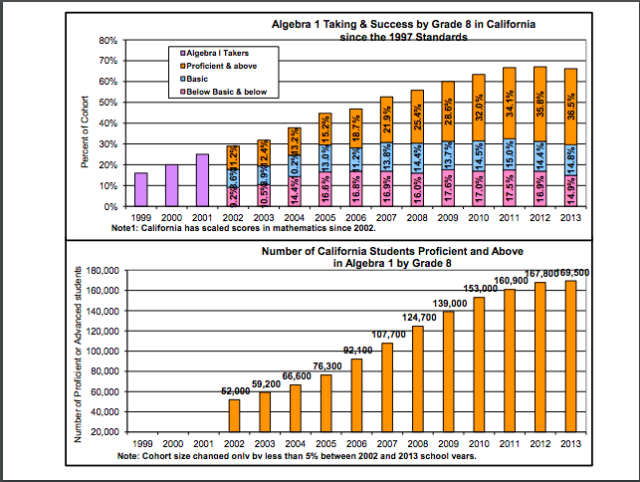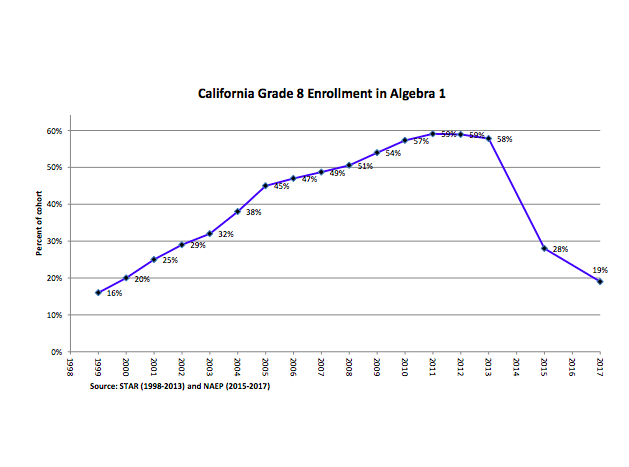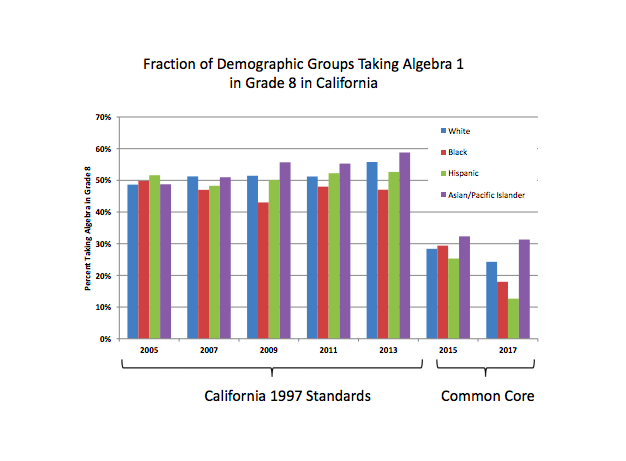
The Common Core curriculum-content standards are a national listing of topics that students are expected to learn in the subjects of English and mathematics. An independent initiative of three Washington, D.C.-based organizations created the national standards, but they were endorsed and promoted by the Obama-era U.S. Department of Education. The standards were released in June 2010. Their summer launch meant that teachers and parents did not have much of an opportunity to discuss their merits and drawbacks. Abiding by the standards was necessary for states to be eligible for massive federal grants. California adopted the national standards and fully implemented them in 2014-2015.
This was a mistake. Looking at how the state’s students performed in math before and after the standards were implemented, it’s clear that the old system served students much better. Before Common Core, California had its own mathematics curriculum-content standards. They had been written largely by the faculty of the Mathematics Department at Stanford University and were adopted by the state in December 1997.
In 2006, when the Thomas B. Fordham Foundation looked at state curriculum-content standards across the country, its reviewers gave California’s 1997 math standards a grade of A and supplied this evaluation:
If any state has math standards right, it’s California. The Golden State’s standards avoid almost all the pitfalls of other states: they call for the use of calculators at the right time and in the right way (the standards do not “allow the use of calculators all through Kindergarten to grade eleven”) and build students’ skills in a logical progression that emphasizes computation, problem-solving, and mathematical reasoning all the way through. Elementary students are directed to memorize basic number facts and develop facility with addition and subtraction. High schoolers are given solid coverage of Algebra, Algebra II, and Geometry, and advanced courses in high school would challenge many college students. … All in all, the state has a top-notch blueprint for mathematical excellence.
Similarly, in “Sizing Up State Standards 2008,” the American Federation of Teachers gave California math standards its top ratings for clarity, specificity, and content.
When California was considering adopting Common Core, then-governor Arnold Schwarzenegger understandably voiced concern that the state’s academic expectations would become less rigorous. He said California should not approve the Common Core standards unless “they meet or exceed our own.”
The deficiencies of Common Core as compared to the 1997 California standards were well documented by mathematicians and other experts. Common Core was not benchmarked to international high-achieving countries despite claiming that this was so; Common Core standards were less clear than the California 1997 standards; Common Core had significant gaps in its content coverage; and, perhaps most obviously, despite its explicit promise to expect algebra and geometry in grade 8 as other countries do, it pushed the Algebra I course firmly into high school.
Despite all those known deficiencies, the California Academic Standards Commission recommended in July 2010 to adopt the Common Core for California, with two opposing votes cast by the authors of this piece. Shortly thereafter, the State Board of Education accepted that recommendation and adopted Common Core for California.
After the 2010 vote, we wrote an opinion piece where we explained why adopting Common Core was the wrong decision for California, and we predicted that only “an elite few students will be able to succeed” in eighth grade algebra under Common Core. Eight years later, that, indeed, seems to be the case.
Algebra I in 8th Grade
Since the 1990s, a major thrust of the effort to improve mathematics achievement in America has been moving an authentic Algebra I course from the high school and into eighth grade. This would be similar to what high-achieving countries have been doing for a long time. It would be comparable with what goes on in the East Asian “Tigers.” Children in Singapore and South Korea, for example, master introductory algebra in eighth grade or earlier. Supporters of this idea have included math education reformers, civil rights leaders such as Robert Moses, and President Bill Clinton during his time in office. As a result, from 1990 to 2007, the nation more than doubled the enrollment of eighth graders in Algebra I.
A consensus existed in the period before Common Core that we should strive to teach Algebra I in eighth grade to as many students as possible. America’s 2008 National Math Panel also recommended this approach. California made immense progress to this end under its 1997 math curriculum-content standards in the decade before Common Core. The success of California encouraged rival states to learn from and to try to match or exceed its accomplishment.
Before the push for Algebra I in eighth grade that came with implementing the 1997 California standards, taking algebra early was the privilege of the few and of the affluent. To put it one way, eighty-four percent of the 1999 cohort of eighth graders in California performed “far below basic” on Algebra I because they simply never had a chance to take it. But then things began to change.
The increase in taking algebra early in California was quite staggering. While in 1999 only 16 percent of students took algebra in eighth grade, four times as many, or 67 percent, took it in 2013 by eighth grade. This huge increase did not lower the success rate. In fact, the success rates of those students kept rising even as their enrollment exploded. To give a better sense of this growth, the number of successful early-algebra-takers rose from about 52,000 in 2002 to about 170,000 in 2013, while the cohort size barely budged.
 Because California set up its 1997 standards to prepare all students for Algebra I in eighth grade and because it attempted to place all those who were ready into such classes, the biggest beneficiaries of this effort were ethnic-minority and low-income students. While the whole cohort success increased by a factor of three, the rates of success jumped by factors of five for African Americans and six for Latinos and low-SES students—double the rate of the whole cohort.
Because California set up its 1997 standards to prepare all students for Algebra I in eighth grade and because it attempted to place all those who were ready into such classes, the biggest beneficiaries of this effort were ethnic-minority and low-income students. While the whole cohort success increased by a factor of three, the rates of success jumped by factors of five for African Americans and six for Latinos and low-SES students—double the rate of the whole cohort.
Even more impressive is the fact that this taking of Algebra I early translated directly into more success in Algebra II and Geometry high school courses. As in the case of early Algebra I, minorities were the prime beneficiaries, enrolling and succeeding at a much faster rate than white students. From 1997 to 2014, California State University, a school system that keeps excellent records on admissions and remediation, found increasingly more qualified students and freshman enrollment more than doubled from around 26,000 to around 63,000, while at the same time remediation rates in mathematics dropped from 52 percent to 27 percent.
 California’s efforts paid off: By the time Common Core actually hit the schools in 2014, the state boasted the highest percentage of students taking algebra by eighth grade in the United States—67 percent, a fourfold increase over 15 years. Fifty-five percent of California’s eighth-grade algebra takers tested “proficient” or “advanced” on the California Standards Test in 2013, up from just under 40 percent in 2002. At its high point in 2013, 67% of middle school students—58% in grade 8, and 9% in grade 7—were enrolled in Algebra I.
California’s efforts paid off: By the time Common Core actually hit the schools in 2014, the state boasted the highest percentage of students taking algebra by eighth grade in the United States—67 percent, a fourfold increase over 15 years. Fifty-five percent of California’s eighth-grade algebra takers tested “proficient” or “advanced” on the California Standards Test in 2013, up from just under 40 percent in 2002. At its high point in 2013, 67% of middle school students—58% in grade 8, and 9% in grade 7—were enrolled in Algebra I.
The key element that enabled the massive surge of minority student success was California’s own K-7 standards—standards that were rigorous and carefully laid out, and that prepared students to take Algebra I in eighth grade. Not every student was ready, but every student who was ready was given a chance to excel and forge ahead, with lasting benefits. And this gave them the opportunity to make it to pre-calculus and calculus in high school, which would prepare them for selective colleges and STEM. California had made remarkable progress in narrowing the achievement gap—a goal often talked about, but rarely accomplished.
From the outset, California’s education officials recognized that improving student achievement so substantially would take time. The state overhauled its entire math curriculum. New instructional plans introduced pre-algebra concepts as early as third grade. School districts augmented on-the-job math training for teachers, approved math textbooks that matched the curriculum, and revised the state accountability system to include teacher supports and rewards for teaching Algebra I by eighth grade.
But with the Common Core standards, this progress began to stall. Common Core expects Algebra I in the ninth grade. That threw a monkey wrench in California’s longstanding effort introducing the math class to students earlier. As seen in the chart below, in the four years under Common Core, the number of eighth graders taking Algebra I in California dropped precipitously to 19 percent in 2017, taking California back to where it was around 1999, when early algebra taking was the privilege of the elite. And while all demographic groups lost ground, the loss for Latino and African American students was much deeper than for white and Asian Americans.

 Common Core proponents repeatedly praise it for its “rigor,” how it will prepare children for the twenty-first century, enable more American students to pursue STEM, and increase America’s competitiveness in the world. Yet when it comes to the clearest benchmark of rigor and expectations on par with international high-achievers—Algebra I in eighth grade—the Common Core not only punted, but it retarded and reversed the progress California had made during the pre-Common Core period, and the Common Core regress disproportionally hit disadvantaged minorities. The reduced rigor in K-8 education has resulted in less enrollment in advanced mathematics courses in high school, particularly of low-income and minority students. This reduces their chances of pursuing challenging and rewarding careers, which we discuss in the next section.
Common Core proponents repeatedly praise it for its “rigor,” how it will prepare children for the twenty-first century, enable more American students to pursue STEM, and increase America’s competitiveness in the world. Yet when it comes to the clearest benchmark of rigor and expectations on par with international high-achievers—Algebra I in eighth grade—the Common Core not only punted, but it retarded and reversed the progress California had made during the pre-Common Core period, and the Common Core regress disproportionally hit disadvantaged minorities. The reduced rigor in K-8 education has resulted in less enrollment in advanced mathematics courses in high school, particularly of low-income and minority students. This reduces their chances of pursuing challenging and rewarding careers, which we discuss in the next section.
High School and College-Readiness
The explosion in early Algebra-taking during the pre–Common Core days translated into rapid growth in advanced math course taking in the high school. Between 2002 and 2013, the number of successful Algebra II students doubled, from about 47,000 to 97,000. The number of successful Geometry students almost doubled from around 69,000 to around 122,000, with successful disadvantaged students growing at double the rate of white students’ growth.
 The increased pre-Common-Core math achievement also drove more students to taking AP Calculus courses. The number of math college-ready students steadily rose from 16 thousand to 31 thousand between 2006 and 2013.
The increased pre-Common-Core math achievement also drove more students to taking AP Calculus courses. The number of math college-ready students steadily rose from 16 thousand to 31 thousand between 2006 and 2013.
Yet all this changed with adoption of Common Core by the state.
The Common Core test chosen by California—the Smarter Balanced (SBAC) test—is administered in high school only in eleventh grade, and the SBAC testing system has no End-of-Course (EOC) tests for high school courses such as Geometry or Algebra II. Consequently, the progress (or lack of progress) of students in advanced math courses was not tracked, both in terms of enrollment and achievement. In fact, even the eighth grade Algebra I enrollment is now only available from a background question of the biannual National Assessment of Education Progress (NAEP).
The only advanced math indicator of achievement left in California is the success of AP calculus takers, and the picture there is discouraging. Before the Common Core standards were adopted, the rate of successful AB and BC Calculus takers by all demographic groups was rising. But that trend has changed direction since Common Core took over, particularly for African American students.
 Before Common Core, college-readiness in California was measured by the state’s own eleventh grade math test (designed for the state Department of Education by Harcourt Brace and later by ETS), augmented by a dozen or so items focusing on topics that CSU faculty felt did not receive sufficient focus in the general state test. Since Common Core, CSU campuses are forced to accept the general state test (SBAC) as the measure of college-readiness, sight unseen, and without any ability to add or modify the test. The results of this cavalier change are seen in the chart below showing the number of students deemed college ready.
Before Common Core, college-readiness in California was measured by the state’s own eleventh grade math test (designed for the state Department of Education by Harcourt Brace and later by ETS), augmented by a dozen or so items focusing on topics that CSU faculty felt did not receive sufficient focus in the general state test. Since Common Core, CSU campuses are forced to accept the general state test (SBAC) as the measure of college-readiness, sight unseen, and without any ability to add or modify the test. The results of this cavalier change are seen in the chart below showing the number of students deemed college ready.
 As can be seen, the number of supposedly college-ready students almost doubled overnight, based on the SBAC test. This is a clear impossibility, indicating the unreliability of the new measure of college-readiness. To add insult to injury, starting this fall CSU has been forced to accept incoming students with that fake college-readiness, and without the ability to place them in remedial classes.
As can be seen, the number of supposedly college-ready students almost doubled overnight, based on the SBAC test. This is a clear impossibility, indicating the unreliability of the new measure of college-readiness. To add insult to injury, starting this fall CSU has been forced to accept incoming students with that fake college-readiness, and without the ability to place them in remedial classes.
Where is all this leading?
California’s adoption of Common Core caused an earthquake in mathematics education in the state. In K-12 education, the gains of the previous 10-15 years—as reflected in large increases in students successfully taking Algebra I early, and in students taking more advanced math courses in high school—have been reversed. As worrisome is the fact that disadvantaged minorities (who made faster gains than the rest of the cohort before Common Core) are losing ground after Common Core at faster rates.
Further, California has lost much of its ability to monitor students’ progress in high school because of the loss of End-of-Course tests. Since 2014, we have been flying blind.
Perhaps the most damaging aspect of Common Core is not its low academic standards, nor the fact that it will likely result in less STEM preparedness in America rather than more. The worst damage is bound to come from the confusion the standards sow among teachers and parents as to what it really means to be “college ready.” Common Core defines college readiness below what have traditionally been the prerequisites for essentially all state colleges across the nation—the completion of Geometry and Algebra II courses. Instead, Common Core puts the readiness level at about half of the traditional Geometry and Algebra II content, suitable at best for community colleges. But by interpreting college-readiness in narrow and uncommon terms, the Common Core falsely assures parents that their children are on a path to college when they are not, and removes parental pressure from schools and kids.
When college-readiness change was decreed, the CSU faculty protested, but they had no ability to approve, disapprove, validate or, for that matter, modify the readiness criterion.
Since remedial classes are gone this Fall, unprepared students will be placed in specially-designed credit courses—often called corequisite or stretch classes—that “will create a sense of progress toward graduation, reduce attrition and expose students right away to a higher level of academic work.” But Jeff Gold, CSU’s assistant vice chancellor for Student Success Strategic Initiatives, Research and Innovation, attempts to convince us that “the academic rigor will not be reduced.”
Here’s what longtime education reformer Chester E. Finn Jr. has to say about “corequisite remediation”:
What, you may reasonably wonder, is “corequisite remediation” besides gobbledygook? Here’s the key sentence: “Make enrollment in college-level courses the default for many more students.”
Which means, of course: Do not send them to remediation, no matter how ill-prepared they may be for college-level work as traditionally defined. Put them in credit-bearing courses anyway.
Yes, some students (and some professors) will rise to that challenge. But what’s the surest way to make this “default” strategy succeed, and thereby prove that it was a great reform? You don’t need a college education to answer that one! Just teach fractions and sentence structure to students in courses that you label “college-level”—even though they’re not. Dumb ‘em down. Cheapen the currency. And again defraud the students (and anyone who might someday contemplate employing them) into believing that they really were prepared for college and are now getting a college education, even though neither of those statements is actually true.
Adopting the Common Core math curriculum standards has proven to be a setback for California. When California had its own mathematics standards before Common Core, its students performed significantly better in math than they have after the Common Core was put into effect. The hardest hit by this change were the most vulnerable students. The state of California Education under Common Core is not good.
Written by Williamson M. Ever and Ze’ev Wurman; published by Hoover Institution ~ May 9, 2018.
~ Author ~
Williamson M. Evers is a research fellow at Stanford University’s Hoover Institution and a former U.S. assistant secretary of education for planning evaluation and policy development. Ze’ev Wurman is an executive at a Silicon Valley semiconductor company and a former senior policy adviser in the U.S. Department of Education. Both were on the California State Academic Standards Commission in 2010 when it evaluated the Common Core’s suitability for adoption by California.
 FAIR USE NOTICE: This site contains copyrighted material the use of which has not always been specifically authorized by the copyright owner. We are making such material available in our efforts to advance understanding of environmental, political, human rights, economic, democracy, scientific, and social justice issues, etc. We believe this constitutes a ‘fair use’ of any such copyrighted material as provided for in section 107 of the US Copyright Law. In accordance with Title 17 U. S. C. Section 107, the material on this site is distributed without profit to those who have expressed a prior interest in receiving the included information for research and educational purposes. For more information go to: http://www.law.cornell.edu/uscode/17/107.shtml
FAIR USE NOTICE: This site contains copyrighted material the use of which has not always been specifically authorized by the copyright owner. We are making such material available in our efforts to advance understanding of environmental, political, human rights, economic, democracy, scientific, and social justice issues, etc. We believe this constitutes a ‘fair use’ of any such copyrighted material as provided for in section 107 of the US Copyright Law. In accordance with Title 17 U. S. C. Section 107, the material on this site is distributed without profit to those who have expressed a prior interest in receiving the included information for research and educational purposes. For more information go to: http://www.law.cornell.edu/uscode/17/107.shtml

So, the common core like curriculum is like not working to well… So I like listen to like all the like people that are like around me and they like all like talk the like same, OK? So I like think that like the like problem is much more hard that you think. So when I like meet with my like friends and we like go out or something we like so like to like….
I listened to a presentation yesterday by “professional” speaker who started every sentence with “SO” and used the word like over 50 times during the 30-minute presentation. During the question and answer period, every question and every answer began with “SO”.
Ending sentences with prepositions… not horrible in conversation but in print? English is a dead language and those that use it or attempt to use it correctly are snobs.
I AM A SNOB… or at least I like try to like be…
What are they teaching in school?
Viva la Revolution’